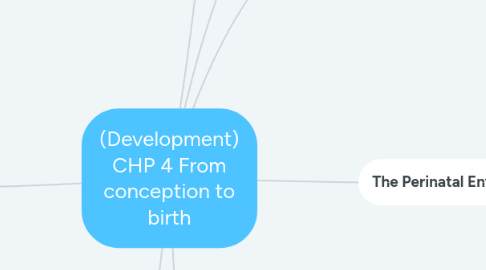
1. First Development
1.1. Females ovulate 28 days
1.1.1. ovum (egg cell) rippens to exists the ovary and travels through the fallopian tube to the uterus
1.1.2. 300 million or so race to the fallopian tube then penetrate the egg
1.1.2.1. Zygote
1.2. Infertility
1.2.1. unable to get pregnant
1.2.2. man or women
1.2.3. Artificial insemination
1.2.3.1. injecting sperm in the uterus
1.2.4. In Vitro Fertilization (IVF)
1.2.4.1. eggs are removed from womens ovary then manually combined with a sperm then returned into womens utures
1.2.4.1.1. egg will implant on the wall of the utures
2. Mothers experience
2.1. Psychological problems
2.1.1. attitude towards pregnancy
2.1.2. knwlage
2.1.3. expectations
2.1.4. sense of control over the birth
2.2. social support
2.2.1. friends and family
2.3. cultural factors
2.3.1. traditional or modern practises
2.4. postpartum depression
2.4.1. clinical depression that lasts months
2.4.2. less securely attached relationship between the child and mom
3. The Neonatal Enviorment
3.1. first month of how parents might optimize the development of thier child
3.2. Beast-feeding or bottle
3.3. Identifying At-risk New borns
3.3.1. Short term or long term
3.3.2. genetic defects, prenatal hazards, prenatal damage
3.3.3. Screened using Apgar test
3.3.3.1. Heart rate, respiration, colour, muscle tone, reflexes
3.3.3.1.1. LBW are examined more closely
3.3.4. Two types of protective factors
3.3.4.1. personal resources
3.3.4.2. supportive postnatal environment
3.4. Kangaroo care
3.4.1. skin to skin
3.4.2. infants born too early or smaller
3.4.3. Resting on a parents chest helps maintain body temperature, heart rate and oxygen levels in the brain . the rhythmic sound of the parents heart beat relaxes the infant and may help stimulate the environment of the womb
3.5. premature infants also benefit from light or moderate massage therapy + such activities improve parents sensitivity to the infant and makes the dynamics among them more positive
3.6. Risk and Resilience
3.6.1. prenatal and perinatal complications decrease over time
3.6.2. early risk depend on the quality of the postnatal development
4. the prenatal environment
4.1. Teratoge
4.1.1. Drugs
4.1.1.1. Cocaine
4.1.1.1.1. Abortion first trimester
4.1.1.1.2. Fetal stroke
4.1.1.1.3. low birth rate
4.1.1.1.4. retarded growth
4.1.1.1.5. Fetal malnutrition
4.1.1.1.6. Premature detachment of the placenta
4.1.1.2. Alcohol
4.1.1.2.1. disrupts hormone functions in the placenta
4.1.1.2.2. Fatal Alchohol sydrom (FAS)
4.1.1.2.3. small head
4.1.1.3. tabacco
4.1.1.3.1. Sudden infant death syndrome (SIDS)
4.1.1.3.2. CNS impairment
4.1.1.3.3. Low birth weight
4.1.1.3.4. prematurly born
4.1.1.3.5. miscarriage
4.1.1.3.6. palates
4.1.1.3.7. cleft lips
4.1.1.4. Thalidomide
4.1.1.4.1. Deformed
4.1.1.4.2. missing body parts
4.1.2. Effects depend on quality of prenatal & postnatal environment
4.1.3. Diseases
4.1.3.1. Rubella
4.1.3.1.1. Early stages
4.1.3.1.2. blindness, deafness, heart problems, mental retardation
4.1.3.2. Diabetes
4.1.3.2.1. premature delivery
4.1.3.2.2. stillbirth or miscarriage
4.1.3.2.3. immature lung development
4.1.3.2.4. Large fetal size
4.1.3.3. Syphilis
4.1.3.3.1. It is an STD
4.1.3.3.2. miscarriage or stillbirth
4.1.3.3.3. blindness, deafness, heart problems, brain damage
4.1.3.4. AIDS
4.1.3.4.1. Acquired immunodeficiency syndrome
4.1.3.4.2. STD caused by HIV
4.1.3.4.3. destroys immune system that makes victims susceptible to infections
4.1.3.4.4. prenatally, perinatally, postnatally
4.1.3.4.5. 15%-35%
4.1.4. environmental agents that may harm fetus
4.1.5. worst when the fetus in critical period
4.1.5.1. organ system grows since the organs are extra sensitive
4.1.6. Radiation or pollution
4.2. Mothers womb
5. Prenatal steps
5.1. 1) Germinal Period
5.1.1. 2 weeks
5.1.2. zygote divides through mitosis
5.1.2.1. Forming the BLASTOCYST
5.1.2.1.1. hollow ball of 150 cells
5.2. 2) Embryonic period
5.2.1. 3 week till 8 week
5.2.2. every major organ takes shape now (ORGANOGENESIS)
5.2.3. layers of the BLASTOCYST differentiate forming structures that sustain development
5.2.3.1. outer layer= AMNION
5.2.3.1.1. A watertight membrane that fills with fluid that cushions and protects the embryo
5.2.3.2. CHORION
5.2.3.2.1. a membrane that surrounds the AMNION and attaches root-like extensions called vili to the uterine lining to gather nourishment for the embryo
5.3. 3) Fetal period
5.3.1. 9 weeks till birth
5.3.2. form brain structures
5.3.3. differentiation
5.3.3.1. every neuron has the potential to become whatever it wants depends on where it migrates
5.3.4. AGE VARIABILITY
5.3.4.1. 23 weeks
5.3.4.2. survival outside uterus is possible CUZ brain and respiratory system sufficiently developed
5.3.5. Develop An insulating over MYELIN that improves ability to transmit signals rapidly
5.4. Miscarriage
5.4.1. Pregnancy short lived
5.5. SPINA BIFIDA
5.5.1. part of spinal cord not fully developed
5.5.2. not fully enclosed in the protective covering of the spinal column
5.5.2.1. neural tubes fail to close
5.5.2.1.1. neurological problems
5.5.2.1.2. fail to close the top of the neural tube can lead to ANENCEPHALY
6. How the mother is doing
6.1. Lamaze method
6.1.1. prepare for child birth
6.1.2. pleasnt feelings to ready themsleves
6.1.3. learning execises
6.1.4. breathing and pushing techniques
6.1.5. relaxation techniques
6.1.6. makes child birth easier
6.2. Age and race/Ethnicity
6.2.1. safest nd typical time =20-40
6.2.2. too old or too young
6.2.2.1. more chances of still births and premature deliveries
6.2.3. Non hispanic black women have fetal death rates twice the rates of other women. they are more susectable to premature labour = health problems
6.3. emotional condition
6.3.1. women emotionally aroused = glands secrete powerful hormones that may cross the placenta barrier = enter the fetus blood stream = temporary stressful situation = if it is prolonged it can cause damage
6.4. nutritional condition
6.4.1. 300 grams of extra calories per day
6.4.2. weight gain of 25-35
6.4.2.1. gain too much = harmful
7. The Perinatal Environment
7.1. Environment surrounding the birth
7.2. drugs used during birth
7.3. delivery practice
7.4. social environment shortly after the birth
7.5. maternal-fetal specialist = perinatologist
7.6. PROBLEMS
7.6.1. Anoxia
7.6.1.1. oxygen shortage during the birth process
7.6.1.2. umbilical cord wrapped around the neck
7.6.1.3. breech presentation
7.6.1.3.1. when the feet or butt comes out first during a vaginal delivery
7.6.2. Cesarean section
7.6.3. complicated delivery
7.6.4. Medications
7.6.4.1. large doses of sedative medications= difficult yo make the baby eat or cuddle

